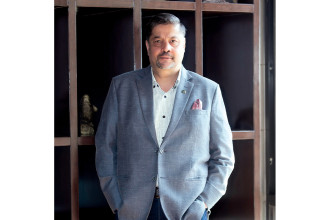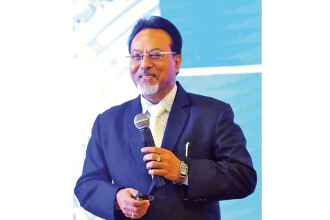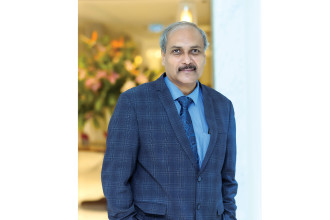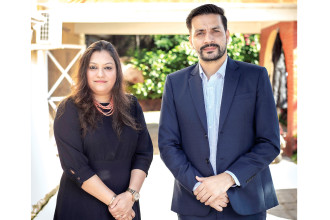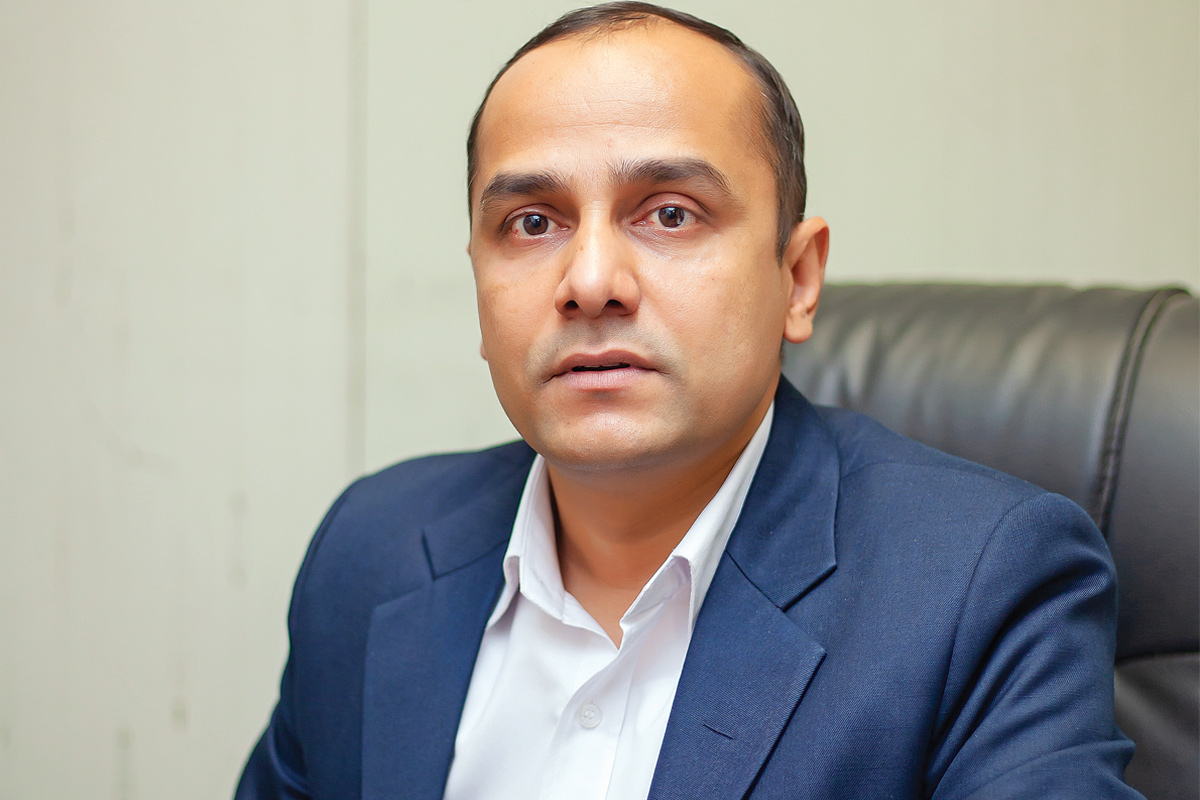
Dr. Samir Kumar Adhikari is a senior Health Administrator and the Joint Spokesperson for the Ministry of Health and Population. He is also the Chief of Health Emergency Operation Center (HEOC) and the Chief of Multi-Sectoral Coordination Section. Health Emergency Operation Center is the Center under Health Emergency Disaster Management Unit, Ministry of Health and Population, Nepal. HEOC’s main objective is to work as a secretariat of MoHP during health emergency and disasters.
Prior to his role as the Joint Spokesperson for MoHP, Dr. Samir was the Chief of Zoonotic and other Communicable Disease Management Section, EDCD. Zoonotic and other Communicable Disease Control Section provides support in preparing national laws, policies, strategies, guidelines for prevention, control, elimination and management of zoonotic diseases including rabies and snake bites.
In an interview with B360’s Avant Shrestha, Dr. Adhikari talks about his role and responsibility as the Joint Spokesperson for MoHP and his role as the head of Health Emergency Operation Center. Along with that, he also discusses the operations and challenges of the ongoing Covid 19 vaccine program. Excerpts:

Can you give us insight into the works and responsibility of the Health Emergency Operation Center?
As the head of the Health Emergency Operation Center, my responsibility is to respond to all kinds of major emergencies that put the country and its population at risk. My major responsibility is to plan, coordinate, and respond to everything that impacts the public health sector. To be more specific, we tend to call it as ‘pre-hospital care’ and ‘post-hospital care’. To further explain about our work; for example, in case of a natural disaster or in a case of mass casualties and/or road traffic accidents, we assess if the hospitals are capable of taking care of the patients. We call it Hub and Satellite Networking where we conduct the necessary coordination with the Hub and Satellite Hospital Network to facilitate service during emergencies and disasters. In this method, we connect big hospitals to small ones. For example, if there are many cases in one hospital, they transfer the cases to the connected hospital. Mostly, the small hospital will be managed and run in the network of the bigger ones. This way, it is very easy to manage skilled manpower and helps us in managing beds and better resource mobilisation. During an infectious disease or pandemic such as in our current case, we are responsible to create a rapid response team in the health sector that responds and coordinates in the community level. Moreover, we have created a medical team and emergency medical deployment team and in case of emergency we are responsible to start the networking and bring them into operation. In addition, during situations of any outbreak, we gather information from the lower levels and send them to the higher authorities. We are responsible to share the information we gathered with the public which is disseminated through various media.During the initial stage of the pandemic when the virus was new and there was a lot of confusion, as the Spokesperson for the Ministry of Health and Population, what were the major challenges and what kind of strategies were applied to mitigate them?
In the initial days, it was very difficult because the officials including the government bodies did not have proper information about the virus. The virus was a new problem for our country as well as the whole world. We had not experienced such kind of pandemic before. We were informed that the situation could be managed by looking at and referring to other countries and at the same time we had to work with different organisations. This was quite challenging in the beginning because we had never worked with so many multi-stakeholders and we were not used to working on such a large scale. Novelty of the disease was one of the biggest problems. Random people would claim to be experts. False rumors about the virus were easily spread and therefore people started distrusting official bodies which was very challenging for us. We had to do a lot of hard work: we conducted studies and were able to come up with valid explanations to the public regarding the science of Covid 19. Besides, while making public announcements we had to ensure sensitivity and that it wasn’t made in an offensive manner. We started channelising the information received slowly. Simulation exercises and drills have helped us. At the onset, explaining to the front-line workers was a daunting task, as well as explaining about ‘quarantine’ and how and what could be improved for better results was equally challenging. We are pleased that we were successful in this.
What is the most commonly misinterpreted information about Covishield vaccine?
When it comes to vaccine and immunisation, it has been challenging to explain and convince well-informed people because they have a lot of opinions and always ask questions. However people who lack knowledge in this matter are easy to convince. Obviously, under normal circumstances, a vaccine would take time to be developed properly but within this year the entire world’s focus, effort and resources has been towards Covid 19 and finding the vaccine for the same. At the same time, the world’s logistics, business, economics and politics is also focused in Covid 19. Resultantly, the vaccine was developed very quickly and was tested in the market. However, people and society are hesitant to take this vaccine. Given the circumstances, the fact that people are doubtful about the vaccine is very normal. It is important to understand that new technologies are being developed and through these new technologies and tools, the vaccine has been developed and we have to accept that the vaccine is our solution for moving forward. One of our additional challenges is that there are a number of rumours and misleading information about the vaccine which I encourage people to not pay attention to. There are chances that lots of negative rumors can be spread about the vaccine in the community level. The vaccine has been developed at such a rapid pace that there is bound to be some rumors and hesitation. Currently, there are various organisations that have helped spread correct information about the vaccine and the importance of taking it. But initially, it was quite a challenge to communicate and convince public about the vaccine.What are the major challenges during the ongoing immunisation drive?
Another aspect about the vaccine is that it has not only become the responsibility of the medical community but the responsibility of the political community as well. First of all, to aquire the vaccine is very difficult. And even after we had received the vaccine, we have to be able to vaccinate the people as soon as possible. Primiarily because after the vaccine has been developed it has to be used within six months, plus there is an issue of storage at right temperatures. Given the context, we have to prioritise the vaccination program. If we weren’t able to vaccinate everyone without a set priority, there would have been a number of issues. For example, we needed to prioritise the health workers and immunise them because they are frontline workers and are very vulnerable; and if they are vaccinated first, there wouldn’t be a health issue for them regardless of Covid 19 or any other diseases. If they are not vaccinated, an infected person might transfer the disease to them and even worse, if they are infected, they may tranfer the diseases to a vulnerable individual. So as a result, in our goal to break the chain, our first priority was to vaccinate the health workers. As of now, it has been more than a month since we started the vaccination programme. In South Asia we are the second country to start the vaccination. When we started the vaccination, many other nations (more than a hundred) had not been able to start the vaccination. Additionally, the availability of the vaccine was prioritied based on storage, effectiveness and efficacy. It was very challenging for us but today our model or vaccine campaign model is being replicated in a number of other countries. It was challenging to explain it to people about how and why it was important to prioritise groups while giving out the vaccine. But currently many have understood and accepted our stance. Eventually, we have dedicated our work efforts to vaccinate the rest of 72% of the public.The government claimed that it is committed to immunising 72% of the total population, however the vaccine cannot be administered to those under the age of 18, which makes up 28% of the total population. What measures are we taking for those under the age of 18?
The vaccine has not been administered to those under the age of 18 because there has been no trial conducted on them. Hopefully, the trial will slowly begin. The Nepal government’s main motive is to vaccinate the target group which is above the age of 18 and consists of 72% of the total population. When the vaccine is invented or developed, the trial has to be successful. We need to have enough scientific evidence to claim that the vaccine is safe and successful for those under the age of 18 and the experts have to give us a go-ahead, only then it would be a plausible idea to move ahead with the program. As of now, without any substantial data or study on the matter, it is very difficult to claim when and how we can start to administer vaccine to those under the age of 18. However, for the 72% of the population who we have aimed to vaccinate, they will continue to get vaccinated as their turn comes. A herd immunity will be developed which basically is the indirect protection from an infectious disease that happens when a population is immune either through vaccination or immunity developed through previous infection. This basically helps break the chain of infection which currently is one of our main objectives.Earlier the Ministry of Health had decided to immunise frontline workers such as health workers, supporting staff, sanitation workers, female community health volunteers, security personnel, elderly people living in old age homes and prisoners from district hospitals only. How do you determine the prioritisation for journalists and other groups?
In the first phase we started with providing vaccination to the health workers, sanitation workers, hospital staff, supporting staff and women social entrepreneurs. In addition, we started vaccinating groups such as diplomats and journalists, the reason being they work in the frontline while reporting on various news and events. For example, journalists have to go around interviewing multiple people and meet many more, as a result he or she can infect or can infect another vulnerable person. Along with the journalists, we gave it to the diplomats but the general public had started raising questions over this decision. The reason for giving the vaccine to diplomats is because they travel to different countries and meet new people every day. Besides, the virus has been changing its form and it being contagious in many countries, there is a chance that such strains of the virus might enter our country. To stop the main point of the source of transfer, we thought of vaccinating the diplomats.The country is still fighting the Covid 19 pandemic and officials have been tirelessly issuing guidelines to maintain social distancing and wear a mask. But these safety precautions were tossed in the garbage bin by participants at political rallies. As the senior health administrator, how do you feel about these turns of events?
Ironically our country has been going through a lot but we also have to learn from the mistakes of other countries. The current situation when it comes to the criticism faced by the government from the public can be considered as normal. The criticism actually helps us improve. Nepal’s containment of the virus has been very successful compared to other countries. This has been achieved through collaborative efforts. Our effort and the initial success have made us feel that Covid 19 is something that cannot harm us.
Published Date: March 30, 2021, 12:00 am
Post Comment
E-Magazine
RELATED Face 2 Face


